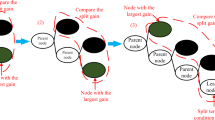Abstract
Metal cutting is a complex nonlinear dynamical process. Analysis of signals from turning operation shows that the machining exhibits a low-dimensional chaos. The self-excited vibration caused by the regenerative effect, usually called chatter, can be created during machining by increasing one cutting parameter, while keeping all other cutting parameters constant. A cross-recurrence plot (CRP) enables the study of synchronisation or time differences in two time series. CRP-based methodology is used to find the point of transition from normal cutting to chatter cutting. In this method, two signals, one input signal (power to the lathe motor) and one output signal (cutting tool vibration), are recorded simultaneously at a constant sampling rate during cutting. A time series is generated from the recorded values, and cross-recurrence plot is prepared. This CRP can be quantified using Cross-Recurrence Quantification Analysis (CRQA). Abrupt variation in the CRQA parameters indicates the onset of chatter vibration. The results are verified using permutation entropy (PE) to detect the onset of chatter from the time series. The present study ascertains that this CRP-based methodology is capable of recognising the transition from regular cutting to the chatter cutting irrespective of the machining parameters or work piece material.





Similar content being viewed by others
References
Quintana, G., Ciurana, J.: Chatter in machining processes: a review. Int. J. Mach. Tools Manuf. 51(5), 363–376 (2011). doi:10.1016/j.ijmachtools.2011.01.001
Gradisek, J., Govekar, E., Grabec, I.: Qualitative and quantitative analysis of stochastic processes based on measured data. II. Applications to experimental data. J. Sound Vib. 252(3), 563–572 (2002). doi:10.1006/jsvi.2001.4051
Landers, R.G., Ulsoy, A.G.: Supervisory machining control: design and experiments. CIRP Ann. 47(1), 301–306 (1998). doi:10.1016/S0007-8506(07)
Choi, T., Shin, Y.S.: Online chatter detection using wavelet based parameter estimation. J. Manuf. Sci. Eng. 125(1), 21–28 (2003)
Soliman, E., Ismail, F.: Chatter detection by monitoring spindle drive current. Int. J. Adv. Manuf. Technol. 13(1), 27–34 (1997). doi:10.1007/BF01179227
Schmitz, T.L., Medicus, K., Dutterer, B.: Exploring once per revolution audio signal variance as a chatter indicator. Min. Sci. Technol. 6(2), 215–233 (2002)
Karpuschewski, B., Wehmeier, M., Inasaki, I.: Grinding monitoring system based on power and acoustic emission sensors. CIRP Ann. 49(1), 235–240 (2000). doi:10.1016/S0007-8506(07)
Marwan, N., Thiel, M., Nowaczyk, N.R.: Cross recurrence plot based synchronization of time series. Nonlinear Process. Geophys. 9(3/4), 325–331 (2002)
Marwan, N., Kurths, J.: Nonlinear analysis of bivariate data with cross recurrence plots. Phys. Lett. A 302(5–6), 299–307 (2002)
Marwan, N., Kurths, J.: Cross recurrence plots and their applications. In: Benton, C.V. (ed.) Mathematical Physics Research at the Cutting Edge, pp. 101–139. Nova Science, Hauppauge (2004). ISBN: 1-59033-939-8
Elias, J., Rajesh, V.G., Narayanan Namboothiri, V.N.: Recurrence quantification analysis applied to sequential speckle images of machined surface for detection of chatter in turning. Proc. SPIE 7064, 706408 (2008). doi:10.1117/12.795777
Franca, L.F., Savi, M.A.: On the time series determination of Lyapunov exponents applied to the nonlinear pendulum analysis. In: Nonlinear Dynamics, Chaos, Control and Their Applications to Engineering Sciences, pp. 356–366. ABCM, Rio de Janeiro (2000)
Kennel, M.B., Brown, R., Abarbanel, H.D.I.: Determining embedding dimension from phase-space reconstruction using a geometrical construction. Phys. Rev. A 25, 3403–3411 (1992)
Fraser, A.M., Swinney, H.L.: Independent coordinates for strange attractors from mutual information. Phys. Rev. A 33, 1134–1140 (1986)
Zbilut, J.P., Giuliani, A., Webber, C.L., Jr.: Detecting deterministic signals in exceptionally noisy environments using cross-recurrence quantification. Phys. Lett. A 246, 122–128 (1998)
Shockley, K., Buttwill, M., Zbilut, J.P., Webber, C.L. Jr.: Cross recurrence quantification of coupled oscillators. Phys. Lett. A 305, 59–69 (2002)
Marwan, N., Kurths, J.: Nonlinear analysis of bivariate data with cross recurrence plots. Phys. Lett. A 302, 299–307 (2002)
Shockley, K.: Cross recurrence quantification of interpersonal postural activity. In: Riley, M.A., Van Orden, G. (eds.) Tutorials in Contemporary Nonlinear Methods for the Behavioral Sciences, pp. 143–177 (2004). Chap. 4
Marwan, N., Wessel, N., Meyerfeldt, U., Schirdewan, A., Kurths, J.: Recurrence plot based measures of complexity and its application to heart rate variability data. Phys. Rev. E, Stat. Nonlinear Soft Matter Phys. 66(2), 026702 (2002)
Webber, C.L. Jr., Zbilut, J.P.: In: Riley, M.A., Van Orden, G. (eds.) Tutorials in Contemporary Nonlinear Methods for the Behavioral Sciences, pp. 26–94 (2004). Chap. 2
Lipski, J., Litak, G., et al.: Surface quality of a work material’s influence on the vibrations of the cutting process. J. Sound Vib. 252(4), 729–737 (2002)
Nair, U., et al.: Permutation entropy based real-time chatter detection using audio signal in turning process. Int. J. Adv. Manuf. Technol. 46, 61–68 (2010)
Cao, Y., et al.: Detecting dynamical changes in time series using the permutation entropy. Phys. Rev. A, Gen. Phys. 70, 046217 (2004)
Rajesh, V.G., Narayanan Namboothiri, V.N.: Flank wear detection of cutting tool inserts in turning operation: application of nonlinear time series analysis. Soft Comput. 14, 913–919 (2010)
Acknowledgement
Software developed by Dr. N. Marwan and Dr. C.L. Webber Jr. is used in the analysis.
Author information
Authors and Affiliations
Corresponding author
Rights and permissions
About this article
Cite this article
Elias, J., Narayanan Namboothiri, V.N. Cross-recurrence plot quantification analysis of input and output signals for the detection of chatter in turning. Nonlinear Dyn 76, 255–261 (2014). https://doi.org/10.1007/s11071-013-1124-0
Received:
Accepted:
Published:
Issue Date:
DOI: https://doi.org/10.1007/s11071-013-1124-0




